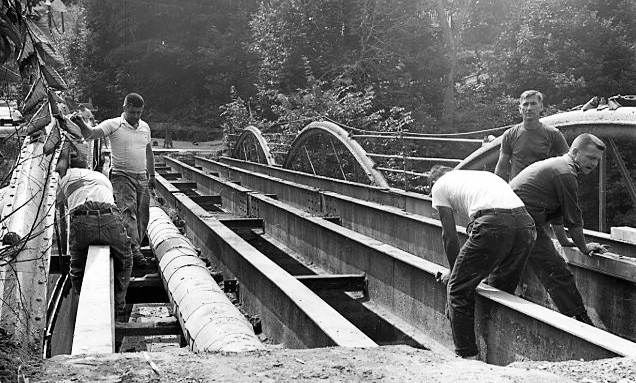Tioronda Bridge
Department of Public Works replacing planking on the bridge, 1968
It has been battered by a swollen creek in the Great Flood of 1902. Over the years it has been altered and re-decked numerous times by city DPW workers. It has made the most honored list a small bridge can attain: the National Register of Historic Places. And in recent decades Its fate has been championed, fought over, neglected, and now, perhaps, sealed in doom.
The Tioronda Bridge, built about 1870, is the focal point of one of the most historic and picturesque places in Beacon. This is the spot (or very close by) where Madam Brett built her grist mill. Fairy Isle, just up the Fishkill Creek from the bridge, is the magical place where local legend has it that the name "Tioronda" was first given to the area by Henry Rowe Schoolcraft, an authority on Indian names who was hiking along the creek with his friend, poet Charles Fenno Hoffman in 1845. Today, with Madam Brett Park on the west side of the creek, and General Joseph Howland's estate Tioronda to the east, you can still walk these parkland trails that are essentially unchanged since the nineteenth century. It is a isolated setting steeped in history. where one can easily imagine a time when farmers' wagons crossed this old bridge hauling lumber and grain to the nearby mills.
The Tioronda Bridge gained state-wide attention in the fall of 1976, when New York's deputy commissioner for Historic Preservation, Julia Stokes, first learned of the bridge and helped push through its nomination for the Historic Register. The bridge's bow string trusses, fabricated by the Ohio Bridge Company, had caught her eye. The bridge's design was unique in the country save for one other like it in Pennsylvania. The bow string trusses, though by then merely decorative in function, the wood decking and the stone pillars all carried an "historic significance in engineering, industry, invention, and transportation," according to Stokes. Indeed, in 1986, when new alterations for the bridge--including its widening to two lanes and an addition of a concrete deck--were being discussed by the DOT in Albany, it was Julia Stokes who became the old bridge's staunchest advocate for preservation. Her voice was heard, and all plans for modernization of the Tioronda Bridge were placed on hold. In 2006, the city administration (unbeknownst to to the state's Preservation Office) had the bow string trusses dismantled and hauled away to storage. This act, according to the state historic office. in effect took the bridge off of the National Register, since no historic elements of the original bridge now remain. A new bridge will be built here. Whether it matches the charm and historic appeal of the old Tioronda Bridge will have to be seen ...
Tioronda Bridge being dismantled, 2006
Tioronda Mills, c. 1870s
Bridge awash in Flood of 1902




